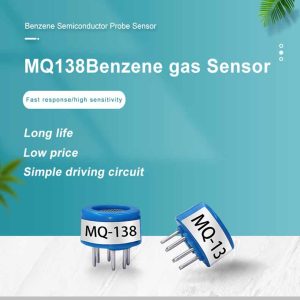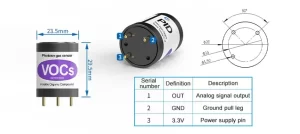-
Advancing Air Quality Monitoring: The Role of Gas Sensors in Environmental Protection
- affecting the health and well-being of millions of people worldwide. To effectively address this challenge, accurate and reliable air quality monitoring systems are essential. Gas sensors play a crucial role in these monitoring systems by……
- Chat Online
-
Description
affecting the health and well-being of millions of people worldwide. To effectively address this challenge, accurate and reliable air quality monitoring systems are essential. Gas sensors play a crucial role in these monitoring systems by detecting and quantifying various pollutants present in the air. This article explores the advancements in gas sensor technology and their pivotal role in environmental protection.

Understanding Gas Sensors
Gas sensors are electronic devices designed to detect and measure the concentration of specific gases in the surrounding environment. They work based on the principle that different gases interact with certain materials, resulting in measurable changes in electrical conductivity, resistance, or other properties. These changes are then converted into electrical signals, which can be analyzed and interpreted to determine the concentration of the target gas.
Gas sensors are commonly used to monitor pollutants such as carbon monoxide (CO), nitrogen dioxide (NO2), ozone (O3), sulfur dioxide (SO2), volatile organic compounds (VOCs), and particulate matter (PM). These pollutants are known to have adverse effects on human health, ecosystems, and the environment as a whole.
Advancements in Gas Sensor Technology
Over the years, gas sensor technology has seen significant advancements, leading to improved accuracy, sensitivity, and reliability. Some notable advancements include:
Miniaturization:
Gas sensors have become increasingly compact and portable, allowing for easy integration into various monitoring systems. This miniaturization has opened up new possibilities for air quality monitoring in both indoor and outdoor environments.
Selectivity and Specificity:
Modern gas sensors exhibit higher selectivity and specificity towards target gases, minimizing cross-sensitivity to other interfering substances. This ensures more accurate and reliable measurements, particularly in complex environments with multiple gas sources.
Low-power Consumption:
Energy-efficient gas sensors have been developed, enabling long-term and continuous monitoring without excessive power requirements. This is especially important for remote or battery-operated monitoring systems.
Wireless Connectivity:
Gas sensors equipped with wireless communication capabilities enable real-time data transmission to centralized monitoring stations. This allows for prompt analysis, decision-making, and timely interventions to mitigate pollution sources.
Applications of Gas Sensors in Environmental Protection
Gas sensors have a wide range of applications in environmental protection and air quality monitoring. Some key areas where gas sensors are utilized include:
Urban Air Quality Monitoring:
Gas sensors are deployed in urban areas to continuously monitor pollutant levels and provide valuable data for policy-makers to develop targeted strategies for pollution control. This helps in reducing public exposure to harmful pollutants and improving overall air quality.
Industrial Emission Monitoring:
Gas sensors are used in industrial settings to monitor emissions and ensure compliance with environmental regulations. By accurately measuring pollutant concentrations, industries can take necessary steps to reduce emissions and minimize their environmental footprint.
Indoor Air Quality Assessment:
Gas sensors are employed in indoor environments such as homes, offices, and schools to assess and improve indoor air quality. This is crucial as people spend a significant amount of time indoors, and poor indoor air quality can have detrimental effects on health and productivity.
Environmental Research:
Gas sensors play a vital role in scientific research aimed at understanding the impact of pollutants on ecosystems and the environment. By providing accurate and reliable data, gas sensors contribute to the development of effective mitigation strategies and policies.
Future Perspectives
The future of gas sensor technology in environmental protection looks promising. As the demand for real-time and accurate air quality monitoring continues to rise, further advancements can be expected. Some potential areas of development include:
Multi-Gas Detection:
Gas sensors capable of simultaneously detecting multiple gases will enable comprehensive air quality monitoring with reduced equipment costs and maintenance requirements.
Improved Sensitivity and Selectivity:
Ongoing research aims to enhance the sensitivity and selectivity of gas sensors, enabling detection and measurement of even trace amounts of pollutants. This will facilitate more precise monitoring and identification of pollution sources.
Integration with Smart Systems: Gas sensors can be integrated with smart systems and the Internet of Things (IoT) for enhanced data collection, analysis, and visualization. This integration will enable real-time monitoring, data sharing, and informed decision-making.
Affordable and Accessible Sensors: Efforts are being made to develop low-cost gas sensors without compromising accuracy and reliability. Affordable sensors would promote wider adoption, allowing for broader air quality monitoring coverage, especially in resource-limited areas.
Conclusion

Gas sensors play a vital and evolving role in environmental protection and air quality monitoring. Advancements in gas sensor technology have significantly improved their accuracy, sensitivity, and reliability, enabling better detection and measurement of pollutants. With further advancements and integration with smart systems, gas sensors will contribute to more effective environmental protection strategies, healthier living environments, and a sustainable future. It is crucial to continue investing in research and development to harness the full potential of gas sensors and address the global air pollution challenge.
-
Recommend:
-
-
Gas detectors are crucial devices used in various industrie…
-
How do gas detectors ensure industrial safety?
Gas detectors play a crucial role in ensuring the safety of…
-
How Gas Sensors Help Combat Air Pollution?
Air pollution is a pressing global issue that poses signifi…
-
How can gas sensors be used in air quality monitoring?
Air pollution is a significant global concern that affects …
-
 : +86 155 8830 2704
: +86 155 8830 2704 : jxdziot@gmail.com
: jxdziot@gmail.com
